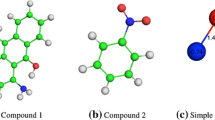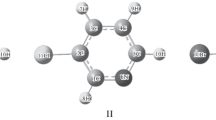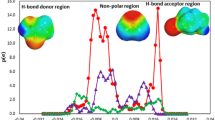Abstract
Molecular dynamics simulations of benzene and 12 fluorobenzenes with various degrees of fluorine substitution in water reveal that the accumulation of water in the first solvent shell decreases with increase in number of fluorine atoms relative to benzene, with an exception of hexafluorobenzene. Further, the solute–solute radial density function indicates that partially substituted fluorobenzenes sample \( \uppi \)-stacked and T-shaped geometries. In contrast benzene and hexafluorobenzene sample only the T-shaped geometries. Comparison of solute–solute and solute–solvent radial density functions suggests that solute–solute interactions is preferred over solute–solvent interaction, which suggests the hydrophobic nature of fluorobenzenes, which increases with increase in number of fluorine atoms on the phenyl ring. The spatial distribution of water around the fluorobenzenes suggests that water avoids the C–F bond group, which indicates increase in hydrophobicity of fluorobenzenes with number of fluorine atoms.







Similar content being viewed by others
References
Dikundwar AG, Sathishkumar R, Row TNG, Desiraju GR (2011) Structural variability in the monofluoroethynylbenzenes mediated through interactions involving ‘organic’ fluorine. Cryst Growth Des 11:3954–3963
Thalladi VR, Weiss HC, Bläser D, Boese R, Nangia A, Desiraju GR (1998) C–H···F interactions in the crystal structures of some fluorobenzenes. J Am Chem Soc 120:8702–8710
Dunitz JD, Schweizer WB (2006) Molecular pair analysis: C–H···F interactions in the crystal structure of fluorobenzene? And related matters. Chem A Eur J 12:6804–6815
Dunitz JD, Taylor R (1997) Organic fluorine hardly ever accepts hydrogen bonds. Chem Eur J 3:89–98
Shimonia L, Glusker JP (2015) The geometry of intermolecular interactions in some crystalline fluorine-containing organic compounds. Sci Cryst Struct Highlights Crystallogr 5:187–203
Rosenberg RE (2018) The strength of hydrogen bonds between fluoro-organics and alcohols, a theoretical study. J Phys Chem A 122:4521–4529
Biswas B, Mondal S, Singh PC (2017) Combined molecular dynamics, atoms in molecules, and ir studies of the bulk monofluoroethanol and bulk ethanol to understand the role of organic fluorine in the hydrogen bond network. J Phys Chem A 121:1250–1260
Dalvit C, Vulpetti A (2016) Weak intermolecular hydrogen bonds with fluorine: detection and implications for enzymatic/chemical reactions, chemical properties, and ligand/protein fluorine nmr screening. Chem A Eur J 22:7592–7601
Champagne PA, Desroches J, Paquin JF (2015) Organic fluorine as a hydrogen-bond acceptor: recent examples and applications. Synthesis 47:306–322
Gerling UIM, Salwiczek M, Cadicamo CD, Erdbrink H, Czekelius C, Grage SL, Wadhwani P, Ulrich AS, Behrends M, Haufe G, Koksch B (2015) Fluorinated amino acids in amyloid formation: a symphony of size, hydrophobicity and α-helix propensity. Chem Sci 5:819–830
Buer BC, Meagher JL, Stuckey JA, Marsh ENG (2012) Structural basis for the enhanced stability of highly fluorinated proteins. Proc Natl Acad Sci 109:4810–4815
Robalo JR, Verde AV (2019) Unexpected trends in the hydrophobicity of fluorinated amino acids reflect competing changes in polarity and conformation. Phys Chem Chem Phys 21:2029–2038
Wilcken R, Zimmermann MO, Lange A, Joerger AC, Boeckler FM (2013) Principles and applications of halogen bonding in medicinal chemistry and chemical biology. J Med Chem 56:1363–1388
Müller K, Faeh C, Diederich F (2007) Fluorine in pharmaceuticals: looking beyond intuition. Science 317:1881–1886
Hagmann WK (2008) The many roles for fluorine in medicinal chemistry. J Med Chem 51:4359–5369
Gutowsky HS, Emilsson T, Arunan E (1993) Low-J rotational spectra, internal rotation, and structures of several benzene–water dimers. J Chem Phys 99:4883–4893
Suzuki S, Green PG, Bumgarner RE, Dasgupta S, Goddard WA, Blake GA (1992) Benzene forms hydrogen bonds with water. Science 257:942–945
Evangelisti L, Brendel K, Mäder H, Caminati W, Melandri S (2017) Rotational spectroscopy probes water flipping by full fluorination of benzene. Angew Chemie 129:13887–13891
Allesch M, Lightstone FC, Schwegler E, Galli G (2008) First principles and classical molecular dynamics simulations of solvated benzene. J Chem Phys 128:014501
Tarakeshwar P, Kim KS, Brutschy B (1999) Fluorobenzene–water and difluorobenzene–water systems: an ab initio investigation. J Chem Phys 110:8501–8512
Lau EY, Gerig JT, Barbara S (1996) Solvent effects on fluorine shielding in fluorobenzene. J Am Chem Soc 118:1194–1200
Hernández-Trujillo J, Vela A (1996) Molecular quadrupole moments for the series of fluoro- and chloro-benzenes. J Phys Chem 100:6524–6530
Van Der Spoel D, Lindahl E, Hess B, Groenhof G, Mark AE, Berendsen HJC (2005) GROMACS: fast, flexible, and free. J Comput Chem 26:1701–1718
Jorgensen WL, Maxwell DS, Tirado-Rives J (1996) Development and testing of the OPLS all-atom force field on conformational energetics and properties of organic liquids. J Am Chem Soc 118:11225–11236
Shimizu K, Gomes MFC, Padua AAH, Rebelo LPN, Lopes JNC (2009) On the role of the dipole and quadrupole moments of aromatic compounds in the solvation by ionic liquids. J Phys Chem B 113:9894–9900
Van Der Spoel D, Van Maaren PJ (2006) The origin of layer structure artifacts in simulations of liquid water. J Chem Theory Comput 2:1–11
Petrova SS, Solovev AD (1997) The origin of the method of steepest descent. Hist Math 24:361–375
Woodcock LV (1971) Isothermal molecular dynamics calculations for liquid salts. Chem Phys Lett 10:257–261
Berendsen HJC, Postma JPM, Van Gunsteren WF, Dinola A, Haak JR (1984) Molecular dynamics with coupling to an external bath. J Chem Phys 81:3684–3690
Feller SE, Zhang Y, Pastor RW, Brooks BR (1995) Constant pressure molecular dynamics simulation: the Langevin piston method. J Chem Phys 103:4613–4621
Allen MP, Tildesley DJ (2017) Computer simulation of liquid, 2nd edn. Oxford University Press, Oxford
Darden T, York D, Pedersen L (1993) Particle mesh Ewald: an N·log(N) method for Ewald sums in large systems. J Chem Phys 98:10089–10092
Hess B, Bekker H, Berendsen HJC, Fraaije JGEM (1997) LINCS: a linear constraint solver for molecular simulations. J Comput Chem 18:1463–1472
Parrinello M, Rahman A (1981) Polymorphic transitions in single crystals: a new molecular dynamics method. J Appl Phys 52:7182–7190
Kumar A, Mahato J, Dixit M, Patwari GN (2019) Progressive hydrophobicity of fluorobenzenes. J Phys Chem B 123:10083–10088
Lum K, Chandler D, Weeks JD (1999) Hydrophobicity at small and large length scales. J Phys Chem B 103:4570–4577
Brutschy B (2000) The structure of microsolvated benzene derivatives and the role of aromatic substituents. Chem Rev 100:3891–3920
Frisch MJ et al. (2016) Gaussian-16 revision B.01 Wallingford CT
Acknowledgements
Authors gratefully acknowledge SpaceTime-2 supercomputing facility at IIT Bombay for the computing time.
Author information
Authors and Affiliations
Corresponding author
Additional information
Publisher's Note
Springer Nature remains neutral with regard to jurisdictional claims in published maps and institutional affiliations.
Rights and permissions
About this article
Cite this article
Kumar, A., Patwari, G.N. Hydration of Fluorobenzenes: A Molecular Dynamics Simulation Investigation. J Indian Inst Sci 100, 221–230 (2020). https://doi.org/10.1007/s41745-019-00157-1
Received:
Accepted:
Published:
Issue Date:
DOI: https://doi.org/10.1007/s41745-019-00157-1




